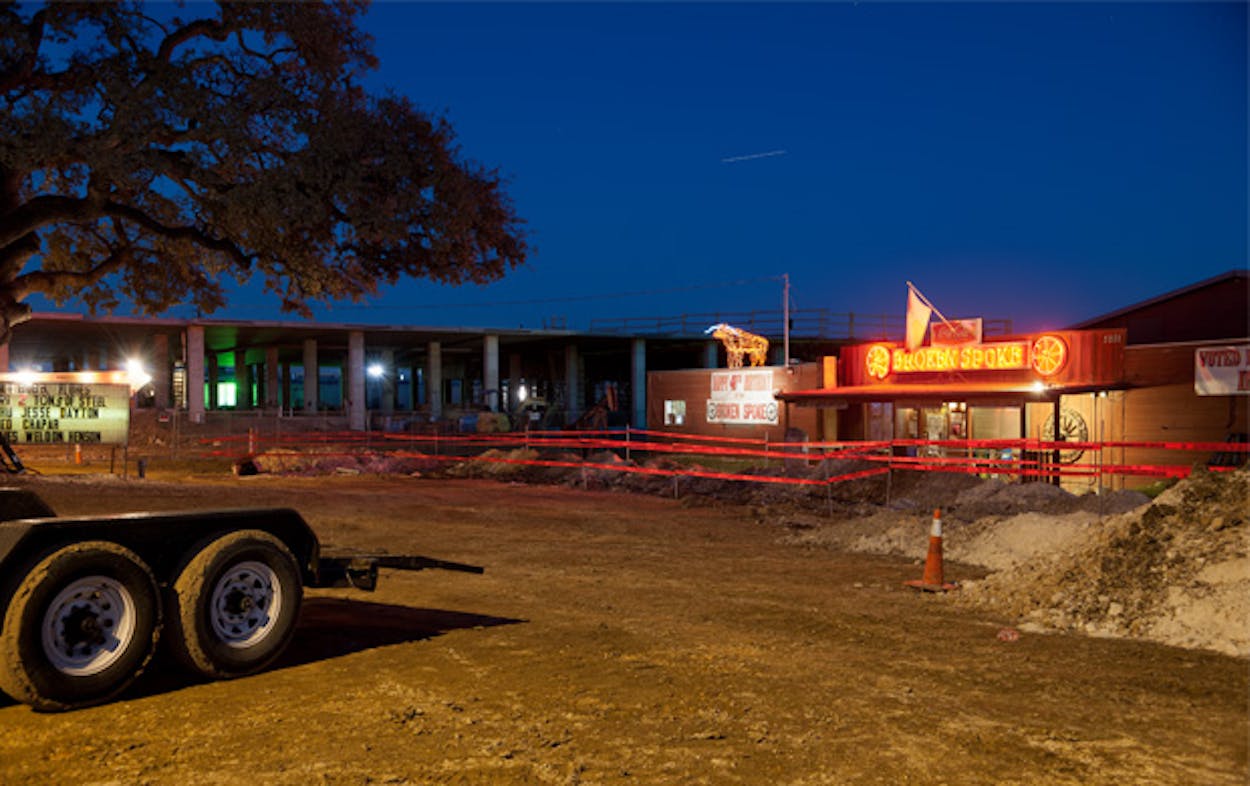Old Austin clashes with New Austin nearly every day, bringing much wailing and worrying from the city’s natives: Will these new condos and luxury hotels rub out everything that makes their weird city great? Will the gigs for hipster musicians dry up? Is $10 guacamole really worth it?
This anguish is not new. A generation of Austinites has fought dramatic battles, losing iconic institutions, like the Armadillo World Headquarters, Liberty Lunch and Las Manitas—all razed to make way for a brave new Austin. But one developer is trying to prove that the New and Old worlds can cohabit.
For the past eight months, the real estate developer Transwestern, a giant real-estate developer, has been overhauling a seven-acre plot of land in South Austin. The area is a mess: bulldozers and excavators sit among tall piles of dirt and rock; twenty-foot-high concrete piers with rebar clawing skyward jut out of the ground; and a jagged eight-foot trench is framed by hundreds of feet of orange-and-white highway barriers lining the road’s shoulder.
At the center of this chaotic scene sits a squat, old, red building, dwarfed by the pipes and slabs, looking like the last proud holdout in a world gone mad. This is the Broken Spoke, and it is arguably the greatest honky-tonk of all time. The Spoke, which was built by James White in 1964, has hosted everyone from Bob Wills and a short-haired guy in a suit named Willie Nelson to an unknown George Strait. The legendary venue attracts tourists from Japan and England and celebrities from Hollywood. They gawk and drink and dance at the most famous club in a city that bills itself the Live Music Capital of the World.
And now Transwestern is trying to save the Spoke while it surrounds it with its own version of New Austin, “The 704,” a $60 million apartment and shopping complex. The 704 (named after the area’s zip code, 78704) will have 385 apartments and 20,000 feet of retail in two five-story buildings flanking the Spoke. The complex will feature a fitness center, a yoga studio and a bocce ball court.
Ty Puckett, Transwestern’s executive vice president of development, understands the cultural importance of the Spoke; he went there back when he attended the University of Texas. “I’ve been here forty years and I’ve seen too many great spots that made Austin Austin get torn down,” he said.
So he worked with the company to preserve it, giving White a ten-year lease (with renewal options), paying for valet parking to make up for the space lost to the construction, and even fixing up the iconic old Texas Top Hands tour bus that has been outside the club since the seventies.
Transwestern also designed the 704 to fit the Spoke’s aesthetic. “We’re integrating design features, like vintage signs, to keep it rustic, keep the downhome south Austin feel,” Puckett said. “Our goal is to make the Spoke feel like an integrated part of the project, not just something we’ve built around.”
Drivers on South Lamar Boulevard look at the construction and think: There is no way the Spoke can survive. White isn’t so sure. “We’re like the Alamo,” he said. “There are a lot of tall buildings around it too, but when you open the door and go inside, you don’t see them—you say, ‘I’m in the Alamo.’ When you open the door here, you think, ‘I’m in the best honky-tonk in Texas.’”
The Spoke hasn’t changed much in 48 years. Patrons still eat chicken fried steak on gingham tablecloths and two-step* to bands like the Derailers and Dale Watson. The ceiling, which in places is so low some men have to doff their cowboy hats, is patched together with warped tiles, particle board, plywood, and corrugated metal. The stage’s art is a Texas flag and a mural of a cowboy singing to a horse. The waitresses look like characters from Tammy Wynette songs.
“When you step on the floor you’re part of something much bigger than just another night out two-stepping,” said Margaret Shaw, a regular. “I don’t know if he meant to, but White created something magical, almost spiritual. It’s like going to church.”
White is there most nights, dressed in jeans and a cowboy shirt and hat, stamping hands and talking to people, many of who thank him for fighting to keep the Spoke open. He thanks them for coming too—crowds are smaller these days (about 50 to 100 fewer people on weekends) because there are so few places to park.
White is confident if he can tough out the next seven months (the north apartments are set to take tenants in August), he will have a new clientele. But he does not plan on changing to fit the new development. The Spoke turns fifty next year, a few months after he turns 75, and when he is ready, he will hand it down to his daughters, and then their children. The Spoke, he said, is not going anywhere.
“When I built the Spoke in 1964, it was surrounded by fields. I worked 16 hours a day, and I never thought I wouldn’t make it. I figured, give the people cold beer, good food at reasonable prices, and a good time—and you’re gonna make it. I feel the same today. I’m not leaving. I’m gonna make it.”
*Correction: An earlier version of this story said the dance floor was made from white pine wood; it is actually a concrete slab. We regret the error.








